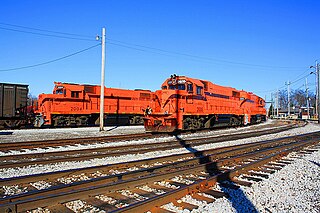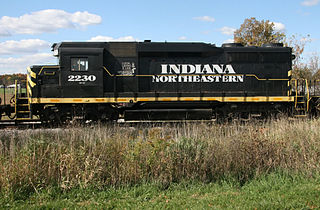Related Research Articles

BNSF Railway is the largest freight railroad in the United States. One of six North American Class I railroads, BNSF has 36,000 employees, 33,400 miles (53,800 km) of track in 28 states, and over 8,000 locomotives. It has three transcontinental routes that provide rail connections between the western and eastern United States. BNSF trains traveled over 169 million miles in 2010, more than any other North American railroad.

CSX Transportation, known colloquially as simply CSX, is a Class I freight railroad company operating in the Eastern United States and the Canadian provinces of Ontario and Quebec. Operating about 21,000 route miles (34,000 km) of track, it is the leading subsidiary of CSX Corporation, a Fortune 500 company headquartered in Jacksonville, Florida.

The Norfolk Southern Railway is a Class I freight railroad operating in the Eastern United States. Headquartered in Atlanta, the company was formed in 1982 with the merger of the Norfolk and Western Railway and Southern Railway. The company operates 19,420 route miles (31,250 km) in 22 eastern states, the District of Columbia, and has rights in Canada over the Albany to Montreal route of the Canadian Pacific Kansas City. Norfolk Southern Railway is the leading subsidiary of the Norfolk Southern Corporation.

The Association of American Railroads (AAR) is an industry trade group representing primarily the major freight railroads of North America. Amtrak and some regional commuter railroads are also members. Smaller freight railroads are typically represented by the American Short Line and Regional Railroad Association (ASLRRA), although some smaller railroads and railroad holding companies are also members of the AAR. The AAR also has two associate programs, and most associates are suppliers to the railroad industry.

Wooden railroads, called wagonways, were built in what became the United States starting from the 1720s. A railroad was reportedly used in the construction of the French fortress at Louisburg, Nova Scotia, in New France in 1720. In 1762–1764, at the close of the French and Indian War (1756–1763), a gravity railroad, Montresor's Tramway, was built by British military engineers up the steep riverside terrain near the Niagara River waterfall's escarpment at the Niagara Portage in Lewiston, New York.

The New York, Susquehanna and Western Railway, also sometimes referred to as New York, Susquehanna and Western Railroad, Susie-Q or the Susquehanna, is a Class II American freight railway operating over 400 miles (645 km) of track in three Northeastern states, New Jersey, New York, and Pennsylvania.

The Alaska Railroad is a Class II railroad that operates freight and passenger trains in the state of Alaska. The railroad's mainline runs between Seward on the southern coast and Fairbanks, near the center of the state. It passes through Anchorage and Denali National Park, to which 17% of visitors travel by train.

The Chicago South Shore and South Bend Railroad, also known as the South Shore Line, is a Class III freight railroad operating between Chicago, Illinois, and South Bend, Indiana. The railroad serves as a link between Class I railroads and local industries in northeast Illinois and northwest Indiana. It built the South Shore Line electric interurban and operated it until 1990, when the South Shore transferred its passenger operations to the Northern Indiana Commuter Transportation District. The freight railroad is owned by the Anacostia Rail Holdings Company.

The Elgin, Joliet and Eastern Railway was a Class II railroad, making a roughly circular path between Waukegan, Illinois and Gary, Indiana. The railroad served as a link between Class I railroads traveling to and from Chicago, although it operated almost entirely within the city's suburbs, only entering Chicago where it served the U.S. Steel South Works on the shores of Lake Michigan. Nicknames for the railroad included "The J" and "The Chicago Outer Belt Line". At the end of 1970, the EJ&E operated 164 miles of track and carried 848 million ton-miles of revenue freight in that year alone.

Conrail, formally the Consolidated Rail Corporation, was the primary Class I railroad in the Northeastern United States between 1976 and 1999. The trade name Conrail is a portmanteau based on the company's legal name. It continues to do business as an asset management and network services provider in three Shared Assets Areas that were excluded from the division of its operations during its acquisition by CSX Corporation and the Norfolk Southern Railway.

Pan Am Railways, Inc. (PAR) is a subsidiary of CSX Corporation that operates Class II regional railroads covering northern New England from Mattawamkeag, Maine, to Rotterdam Junction, New York. Pan Am Railways is primarily made up of former Class II regional railroads such as Boston and Maine Corporation, Maine Central Railroad Company, Portland Terminal Company, and Springfield Terminal Railway Company. It was formerly known as Guilford Transportation Industries and was also known as Guilford Rail System. Guilford bought the name, colors, and logo of Pan American World Airways in 1998.

The Michigan Central Railroad was originally chartered in 1832 to establish rail service between Detroit, Michigan, and St. Joseph, Michigan. The railroad later operated in the states of Michigan, Indiana, and Illinois in the United States and the province of Ontario in Canada. After about 1867 the railroad was controlled by the New York Central Railroad, which later became part of Penn Central and then Conrail. After the 1998 Conrail breakup, Norfolk Southern Railway now owns much of the former Michigan Central trackage.

The Toledo, Peoria and Western Railway is a short line railroad that operates 247 miles (398 km) of track from Mapleton, Illinois, through Peoria across Illinois to Logansport, Indiana. TP&W has trackage rights between Galesburg, Illinois, and Peoria, between Logansport and Kokomo, Indiana, and between Reynolds, Indiana, and Lafayette, Indiana. TPW has connections with UP, BNSF, NS, CSXT, CN, CP, BL, CERA, CIM, KBSR and T&P. The railroad is now owned by Genesee & Wyoming Inc. The railroad's traffic comes largely from agricultural products, including both raw and processed grain products, as well as chemicals and completed tractors. The TPW hauled around 26,000 carloads in 2008.

The Indiana Southern Railroad is a Class III, short line railroad operating in the United States state of Indiana. It began operations in 1992 as a RailTex property and was acquired by RailAmerica in 2000. RailAmerica was itself acquired by Genesee & Wyoming in December 2012.

The Central Railroad Company of Indiana is a Class III short-line railroad that owns 92 miles (148 km) of track between Cincinnati, Ohio, and Shelbyville, Indiana, with trackage rights on CSX to Indianapolis, Indiana. CIND interchanges with CSX, Indiana & Ohio Railway, and Norfolk Southern in Cincinnati, and in North Bend, Ohio, with CSX; an Indiana & Ohio branchline splits from the CIND line at Valley Junction, a railroad location near Hooven, Ohio.

The Indiana Northeastern Railroad is a Class III short line freight railroad operating on nearly 130 miles (210 km) in southern lower Michigan, northeast Indiana and northwest Ohio. The Indiana Northeastern Railroad Company began operations in December 1992 and is an independent privately owned company. As of 2017 the railroad hauled more than 7,000 carloads per year. Commodities moved by the railroad include corn, soybeans, wheat and flour. It also handles plastics, fiberboard, aluminum, copper, coal, perlite, stone, lumber, glass, rendering products, as well as agricultural fertilizers and chemicals.
The Indian Creek Railroad is a short-line railroad in Madison County, Indiana, United States. The 4.55-mile (7.32 km) line is owned by Kokomo Grain Company, an agricultural products and services company, and connects their property at 40°11′30″N85°44′40″W with the Norfolk Southern Railway's Marion Branch in northern Anderson, carrying outbound grain and inbound fertilizer.
The Indiana Boxcar Corporation (IBC), based in Connersville, Indiana, United States, provides services such as locomotive leasing to the rail industry. It also owned several short-line railroads which operated lines under contract for their owners:
The Wabash Central Railroad is a short-line railroad that operates between Van Buren and Craigville, United States, crossing a Norfolk Southern Railway line in Bluffton. It was owned by RMW Ventures, LLC and began operations in 1997, replacing the Indiana Hi-Rail Corporation on an ex-Toledo, St. Louis and Western Railroad line.
References
- ↑ "Indiana Hi-Rail Corporation (United States), RAILWAY SYSTEMS AND OPERATORS". Jane's World Railways. September 28, 2000. Retrieved 2008-10-09.
- "Investor Group Wants to Buy Railroad Business of Bankrupt Indiana Hi-Rail". The News-Sentinel, Fort Wayne, Ind., via Knight Ridder/Tribune Business News. April 28, 1997. Retrieved 2008-10-09.